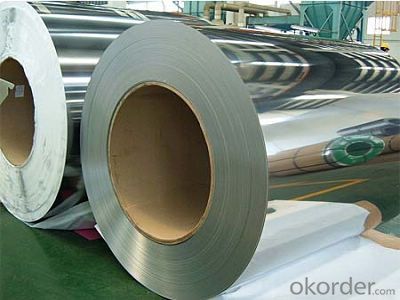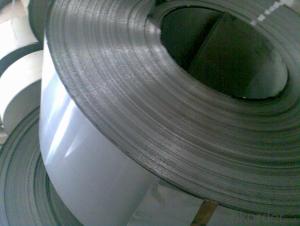We Are Supplying Stainless Steel Coil Sheet
- Loading Port:
- Shanghai
- Payment Terms:
- TT OR LC
- Min Order Qty:
- 10 m.t.
- Supply Capability:
- 2000 m.t./month
OKorder Service Pledge
OKorder Financial Service
You Might Also Like
1.Description:
There are cold rolled steel plate and hot rolled plate, the surface is glossy, matte, matte. Commonly known as stainless steel plate, plate 2B, Ba plate. It may also be according to the customer request plating other light color. Specification sheet are mainly: 1m * 1m 1m*2m 1.22m*2.44m 1.5m*3m 1.5m*6m. If the customer demand, we can be cut according to the size of the customer. Another generation of drawing board, skid plate, plating.
2.Products characteristic:
Stainless steel pipe, seamless pipe and welded pipe (ERW, decorative pipe, welded pipe, pipe, tube light). There are more than 200 kinds of Standard Specification for stainless steel pipe, both large and small, seamless tube is mainly used for industrial, surface for fog face, not bright. Seamed tube surface is bright surface, inner tube has a very fine welding line, commonly known as welded pipe, mainly used for decorative materials. Another industrial fluid tube, the pressure resistance wall thick decided the landscape fragment and 310S heat-resistant tube.1080 degrees below to normal use, the highest temperature reached 115 degrees.
stainless steel plate, cold rolled steel plate and hot rolled plate, the surface is glossy, matte, matte. Commonly known as stainless steel plate, plate 2B, Ba plate. It may also be according to the customer request plating other light color. Main specifications of the plate are: 1m * 1m 1m*2m 1.22m*2.44m 1.5m*3m 1.5m*6m. If the customer demand, we can cut according to the size of the customer. Another generation of drawing board, skid plate, plating.The width of the membrane is not constant, there are: 30mm.60mm.45mm.80mm.100mm.200mm, etc., according to customer requirements of the sub article.
3. Specification:
Stainless steel hot rolled coil thickness: 1.5-15 width 1000 or 1219 or 1500 or 1800 or 2000 (including flash)
Cold-rolled stainless steel: thickness 0.3-3.0 width of 1000 or 1219 or 1500 (including flash)
Stainless steel cold rolled plate thickness: 0.1-3.0 width of 500 or 1600 (including flash).Stainless steel 3.0*1219*C (2.7 NO.4 0.35*1219*C matte, (BA board), 0.4*1219*C (0.3), 0.6*1
4.Reference picture:


- Q:How are steel coils inspected for color consistency?
- Steel coils are inspected for color consistency using a variety of methods to ensure that the final product meets the desired specifications. One common method is visual inspection, where trained inspectors examine the steel coils under controlled lighting conditions to detect any variations in color. This is done by comparing the color of each coil to a standard color chart or a previously approved sample. Any discrepancies are noted and further analysis is conducted. Additionally, advanced technologies such as spectrophotometers may be employed to measure the color of the steel coils objectively. Spectrophotometers use light to measure the reflective properties of the steel surface, allowing precise color analysis. The obtained color data is then compared to the specified color range, and any deviations are flagged for further investigation. Furthermore, some manufacturers may use automated color measurement systems, such as colorimeters or color cameras, to inspect steel coils for color consistency. These systems can quickly and accurately assess the color of each coil, ensuring uniformity across the entire batch. Overall, the inspection of steel coils for color consistency involves a combination of visual inspection, spectrophotometry, and automated color measurement systems. This comprehensive approach helps to guarantee that the steel coils meet the required color standards, providing consistent and high-quality products to customers.
- Q:What material is strongest? Human bone, steel, or concrete?
- Takfam is correct, but in the loooong run, concrete will exist for thousands of years after the steel oxidized, deteriorates, and disappears. The ancients compounded concrete even before the Romans (I can't recall but during the time of the Assyrians), and concrete is almost forever.
- Q:what do they use to make stainless steel?and can stainless steel be melted again and again without losing it's Specifications
- The stainless steel is a family of ferrous alloys containing at least 11% chromium. The effect of this amount of chromium in steel in reducing corrosion is dramatic. There are many grades of stainless steels. By varying the chemical composition, heat treating, and cold-working, a wide range of properties is achieved. There are three types of precipitation hardening stainless steels: *martensitic types, which are supplies in the martensitic condition, are hardened by a simple aging treatment of the fabricated part. *Semi austenitic types, which are supplied in the austenitic condition, are transformed to martensite by special heat treatment before precipitation hardening. *the austenite in the austenitic types is precipitation hardened directly. The heat treatments of precipitation-hardening stainless steels are chosen to optimize mechanical properties. Precipitation hardening generally results in a slight increase in corrosion susceptibility and an increased susceptibility to hydrogen embrittlement.
- Q:What are the common applications of cold-rolled steel coils?
- Cold-rolled steel coils have a wide range of common applications in various industries due to their exceptional qualities. One of the most common applications is in the automotive industry, where cold-rolled steel coils are used to manufacture car parts such as body panels, chassis components, and structural reinforcements. The high strength and excellent formability of cold-rolled steel make it ideal for these applications. Another common application is in the construction industry, where cold-rolled steel coils are used to fabricate structural elements for buildings and infrastructure. Cold-rolled steel is often used to make beams, columns, and other load-bearing components due to its superior strength and durability. Cold-rolled steel coils are also widely used in the manufacturing of appliances and consumer goods. They are commonly used to create the outer shells of refrigerators, washing machines, and ovens. The smooth and consistent surface finish of cold-rolled steel makes it perfect for these applications, as it provides an aesthetically pleasing appearance. Additionally, cold-rolled steel coils find applications in the electrical industry. They are used to produce electrical enclosures, transformers, and various other components due to their excellent electrical conductivity and magnetic properties. Overall, the common applications of cold-rolled steel coils span multiple industries, including automotive, construction, appliances, and electrical. The versatility, strength, formability, and aesthetic appeal of cold-rolled steel make it a preferred choice for many manufacturers in various sectors.
- Q:How are steel coils used in the production of industrial tanks?
- Steel coils are used in the production of industrial tanks as they are rolled into cylindrical shapes and welded together to form the tank's body. The coils provide a durable and strong structure, capable of withstanding high pressure and temperature conditions. Additionally, the steel coils can be customized to meet specific size and shape requirements, allowing for efficient and cost-effective tank production.
- Q:What is the type of stainless steel used in knifes.
- There okorder / Stainless steel doesn't make the best knife blade. It doesn't sharpen as sharp or hold its edge as well. High carbon steel is better, but it rusts and discolors very easily so it's not as popular. A new thing (actually not new but popular these days) is to use a 'sandwich' of high carbon steel between two layers of stainless. So the actual edge is high carbon steel but the blade looks like stainless. I have some kitchen knives made this way (kind of expensive) and I love them. This same technique was used in Japanese katanas, swords used by samurai warriors.
- Q:How do steel coils contribute to the manufacturing of appliances?
- Steel coils play a crucial role in the manufacturing of appliances. These coils are typically made from high-quality steel and are used in various stages of appliance production. Firstly, steel coils are used in the fabrication of appliance components. Manufacturers use these coils to create the outer and inner casings of appliances such as refrigerators, washing machines, and dishwashers. The sturdy nature of steel ensures durability and provides a protective barrier for the inner workings of the appliance. Moreover, steel coils are utilized in the production of appliance parts. These coils are often cut, shaped, and formed into smaller components like brackets, frames, and panels. These parts are essential for the proper functioning of appliances and contribute to their overall performance and longevity. Steel coils also contribute to the manufacturing of appliance doors. The coils are molded and shaped to create the doors, which are crucial for the accessibility and safety of the appliance. Steel doors offer strength, security, and insulation, making them an ideal choice for appliances. Furthermore, steel coils are used in the manufacturing of heating elements and burners in appliances like stoves and ovens. These coils are designed to withstand high temperatures and provide efficient heat transfer, ensuring the appliances can cook or bake food effectively. Overall, steel coils are an integral part of the appliance manufacturing process. They are used to create the outer casings, essential components, doors, and heating elements of appliances. The use of steel in these applications enhances durability, safety, and overall performance, making appliances more reliable and long-lasting.
- Q:Can steel coils be coated with zinc-nickel alloy?
- Yes, steel coils can be coated with zinc-nickel alloy.
- Q:I am doing an assignment for my materials class, im not asking for the answer but just some help. I have the assignment finished and handed in but the teacher gave it back with one comment, he asked me to explain the grain growth in steel during hydraulic press bending. Im completely stuck, please help. Thanks.
- Grain Growth In Metals
- Q:What are the common quality issues with steel coils?
- Common quality issues with steel coils include surface defects such as scratches, rust, or mill scale, dimensional deviations, coil breaks or bursts, edge wave, and coil set. Other issues may include variations in chemical composition, hardness, or tensile strength, as well as improper winding or packaging, which can lead to damage or deformation during transportation or storage.
1. Manufacturer Overview |
|
|---|---|
| Location | |
| Year Established | |
| Annual Output Value | |
| Main Markets | |
| Company Certifications | |
2. Manufacturer Certificates |
|
|---|---|
| a) Certification Name | |
| Range | |
| Reference | |
| Validity Period | |
3. Manufacturer Capability |
|
|---|---|
| a)Trade Capacity | |
| Nearest Port | |
| Export Percentage | |
| No.of Employees in Trade Department | |
| Language Spoken: | |
| b)Factory Information | |
| Factory Size: | |
| No. of Production Lines | |
| Contract Manufacturing | |
| Product Price Range | |
Send your message to us
We Are Supplying Stainless Steel Coil Sheet
- Loading Port:
- Shanghai
- Payment Terms:
- TT OR LC
- Min Order Qty:
- 10 m.t.
- Supply Capability:
- 2000 m.t./month
OKorder Service Pledge
OKorder Financial Service
Similar products
New products
Hot products
Related keywords































